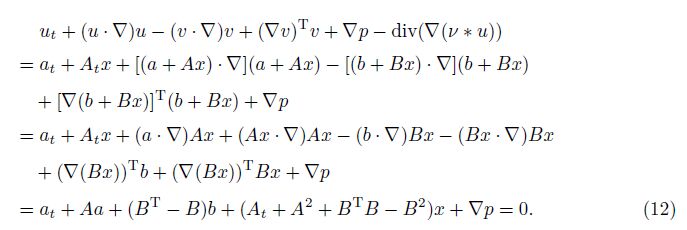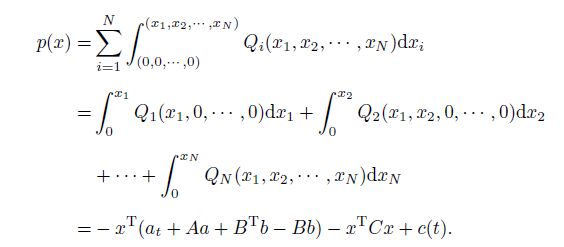Article Information
- Ping LIU. 2016.
- A class of exact solutions for N-dimensional incompressible magnetohydrodynamic equations
- Appl. Math. Mech. -Engl. Ed., 37(2): 209-214
- http://dx.doi.org/10.1007/s10483-016-2025-8
Article History
- Received Mar. 2, 2015;
- in final form Jul. 8, 2015
We shall consider exact solutions of the magnetohydrodynamic (MHD) equations[1, 2, 3]



The dynamics of fluids in electromagnetic fields such as plasma,liquid metals,and salt water can be described by the MHD equations. Such flows may arise both in laboratory and astrophysical situations and can be often assumed to have an axial symmetry. This system is of interest for various reasons. For example,it includes some known equations,such as incompressible Navier-Stokes equations for v = 0[4, 5, 6, 7],and incompressible Euler equations for v = 0,υ = 0[8]. Therefore,the study of systems (1)-(3) can help the understanding of the Navier-Stokes equations and the Euler equations. A set of exact analytical solutions of the axisymmetric MHD equations was given for stationary and incompressible flows[9]. Global existence of strong solutions of the regularized MHD system was proved[10]. The regularity criteria to the 2D generalized MHD equations with zero magnetic diffusivity were considered[11]. However,due to the complexity of MHD equations,it is still difficult to find exact solutions for general time-dependent MHD equations.
The purpose of this paper is to find a sufficient and necessary condition for existence of a class of vector exact solutions of time-dependent MHD equations (1)-(3) as follows:


This paper is arranged as follows. In Section 2,we present a main result to show that the N-dimensional incompressible MHD equations admit the Cartesian solutions. Some illustrative examples are provided in Section 3 as applications of the main result.
2 Main resultsOur main results on existence of solutions are stated as follows. Theorem 1 If the matrices A,B,and C = (At + A2 + BTB − B2B)/2 satisfy














It follows from the condition (14),the function p is a complete differential,that is,


Remark 1 From (10) and (14) in the proof of this theorem,we may find that the conditions (5)-(6) actually are sufficient and necessary conditions for existence of solutions (7)-(8).
Remark 2 For the linear solution (4),it naturally holds that

Let us consider the 2D MHD equations as a special case of Theorem 1. Example 1 Let








Specially,we take


As a special case of Theorem 1,we give a simple corollary. Corollary 1 If the symmetric constant matrices A,B satisfy


Proof It is easy to verify that the conditions (5)-(6) in Theorem 1 are satisfied under the conditions (22)-(23). Therefore,the incompressible MHD equations (1)-(3) admit the solutions (7)-(8).
From this corollary,we just take a,b,A,and B to satisfy Corollary 1,then,all functions (7)-(8) are solutions of the incompressible MHD equations (1)-(3). There are infinite such solutions to be directly constructed very easily. Let us see an example.
Example 2 As a special case of Corollary 1,set


In this paper,based on algebraic techniques of vectors,matrices and curve integration,we have found necessary and sufficient conditions for existence of vector solutions for the general N- dimensional incompressible MHD equations. Among the solutions,to the best of our knowledge, some should be previously unknown. In addition,for incompressible MHD equations,the obtained solutions are still of linear forms about the spatial variable x. Therefore,a natural question is for the appropriate p,whether we could find solutions u,v in the nonlinear form about x. This question is difficult and worthy to be considered.
| [1] | Duvaut, G. and Lions, J. L. Inéquations en thermóelasticitéet magnétohydrodynamique. Archive for Rational Mechanics Analysis, 46, 241-279(1972) |
| [2] | Tran, C. V., Yu, X., and Zhai, Z. On global regularity of 2D generalized magnetohydrodynamic-sequations. Journal of Differential Equations, 254, 4194-4216(2013) |
| [3] | Wu, J. Bounds and new approaches for the 3D MHD equations. Journal of Nonlinear Science, 12, 395-413(2002) |
| [4] | Kato, T. Remanks on the Euler and Navier-Stokes equations in R2, part 2. Proccedings of Sym-posium in Pure Mathematics, 45, 1-7(1986) |
| [5] | Hui, W. H. Exact solutions of the unsteady two-dimensional Navier-Stokes equations. Journal of Applied Mathematical Physics, 38, 689-702(1987) |
| [6] | Zelik, S. Spatially nondecaying solutions of 2D Navier-Stokes equations in a strip. Glasgow Math-ematical Journal, 49, 525-588(2007) |
| [7] | Zelik, S. Weak spatially non-decaying solutions for the 3D Navier-Stokes equations in cylindrical domains. Instability in Models Connected with Fluid Flows /, 7, 255-327(2008) |
| [8] | Arnold, V. I. Sur la topologie des ecoulements stationnaires des fluides parfaits. Comptes Rendus Hebdomadaires Des séances De L'académie Des Sciences, 261, 17-20(1965) |
| [9] | Bacciotti, F. and Chiuderi, C. Axisymmetric magnetohydrodynamic equations: exact solutions for stationary incompressible flows. Physical Fluids B, 4, 35-43(1992) |
| [10] | Fan, J. H. and Ozawa, T. Regularity criteria for the 2D MHD system with horizontal dissipation and horizontal magnetic diffusion. Kinetic and Related Models, 7, 45-56(2014) |
| [11] | Ye, Z. Two regularity criteria to the 2D generalized MHD equations with zero magnetic diffusivity. Journal of Mathematical Analysis and Applications, 420, 954-971(2014) |
 2016, Vol. 37
2016, Vol. 37


